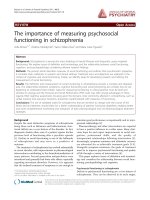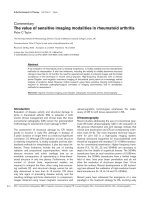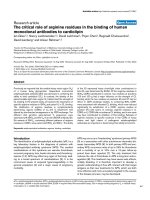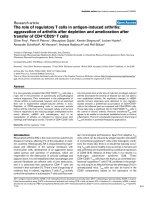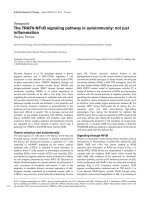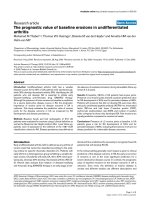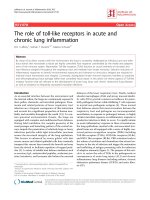Báo cáo y học: "The International Sepsis Forum’s controversies in sepsis: my initial vasopressor agent in septic shock is dopamine rather than norepinephrine" pptx
Bạn đang xem bản rút gọn của tài liệu. Xem và tải ngay bản đầy đủ của tài liệu tại đây (38.21 KB, 3 trang )
6
Critical Care February 2003 Vol 7 No 1 Vincent and de Backer
Septic shock is associated with profound cardiovascular
alterations that frequently necessitate administration of
vasopressor agents in order to maintain arterial pressure.
Norepinephrine and dopamine are the two adrenergic agents
that are commonly used in the treatment of septic shock that
persists despite adequate fluid therapy. Dopamine has
stronger β-adrenergic properties than does norepinephrine,
and additional dopaminergic effects that can selectively
increase splanchnic and renal blood flow. Over the years
studies have investigated the effects of vasopressor agents
on various aspects of the septic shock response, including
systemic haemodynamics and oxygenation, and more
recently regional blood flows and oxygenation, with the
ultimate aim of determining which vasopressor, if any, has the
superior profile and which vasopressor improves outcome
the most. However, although there is a plethora of animal
studies, there are few good clinical studies comparing the
available agents, and recent expert panels have been unable
to recommend one drug over another [1]. The debate,
therefore, continues as to which catecholamine, if any, is to
be preferred in the patient with septic shock.
In the present issue of Critical Care, Sharma and Dellinger
[2] raise a number of arguments that favour norepinephrine
over dopamine. However, we feel that their case lacks
potency for the reasons discussed below, taking each of their
sections in turn.
Norepinephrine produces less tachycardia
This is indeed true, although because dobutamine is often
administered with norepinephrine to provide cardiac support,
and dobutamine increases heart rate, clinically this factor is
of little relevance. In addition, is tachycardia really a problem?
The normal response to a severe infection is an increase in
cardiac output secondary to increases in both stroke volume
and heart rate. It may even be an advantage to have some
degree of tachycardia in these conditions. Moreover, this
tachycardia is usually well tolerated; it is rare to see the
development of myocardial ischaemia secondary to septic
shock. Admittedly, in some cases, in which the heart rate is
very fast, preference could be given to norepinephrine, but
these are exceptional cases.
Commentary
The International Sepsis Forum’s controversies in sepsis: my
initial vasopressor agent in septic shock is dopamine rather than
norepinephrine
Jean-Louis Vincent
1
and Daniel de Backer
2
1
Head, Department of Intensive Care, Erasme University Hospital, Brussels, Belgium
2
Staff member, Department of Intensive Care, Erasme University Hospital, Brussels, Belgium
Correspondence: Professor Jean-Louis Vincent, email:
Published online: 9 December 2002 Critical Care 2003, 7:6-8 (DOI 10.1186/cc1851)
This article is online at />© 2003 BioMed Central Ltd (Print ISSN 1364-8535; Online ISSN 1466-609X)
This article is based upon a presentation at the 31st Annual Congress of the Society of Critical Care Medicine (SCCM), San Diego, California,
USA, 26–30 January 2002. The presentation was supported by the International Sepsis Forum (ISF).
Abstract
Norepinephrine (noradrenaline) and dopamine are commonly used first-line vasopressor agents in the
treatment of patients with septic shock. Recently increasing interest has focused on whether one or other
of these agents is superior in terms of improving outcome. Studies have looked particularly at the possible
local effects of the vasopressors on splanchnic circulation, because evidence suggests that this area is
important in the development and maintenance of septic shock. However, the many studies performed
have yielded conflicting data and there is, as yet, little evidence to support one drug over the other in
terms of their splanchnic effects. Overall, though, dopamine has many assets that make it a good first-line
drug when compared with norepinephrine, and these are highlighted in the present, brief commentary.
Keywords outcome, splanchnic blood flow, vasopressors
7
Available online />Norepinephrine increases cardiac index
This is an advantage of dopamine and actually a major
advantage. Although some studies have demonstrated an
increased cardiac index with norepinephrine, generally
norepinephrine raises blood pressure via its vasoconstrictive
effects, with little effect on cardiac index. Hence,
norepinephrine carries a risk for decreasing blood flow to the
tissues, and additional dobutamine is usually required to
improve cardiac function and balance these effects.
Norepinephrine has no deleterious effect on
cerebral perfusion pressure
This is true. Of course, a vasopressor will result in a higher
mean arterial pressure and, therefore, a higher cerebral
perfusion pressure. However, is this really a problem in septic
shock? When septic shock resolves, the patient usually has
no neurological sequelae.
Norepinephrine has no effect on the
hypothalamic–pituitary axis
This is indeed true, because dopamine administration can
reduce the release of a number of hormones from the
anterior pituitary gland, including prolactin [3,4]. However, if
dopamine is used only for limited periods of time (as in shock
resuscitation), then the deleterious effects of this action have
not been demonstrated.
More effective and better outcome with
norepinephrine compared with dopamine
Although the study quoted by Sharma and Dellinger, that by
Martin and coworkers [5], does show improved outcome for
the patients treated with norepinephrine, that study was a
nonrandomized observational study, and the results must
therefore be treated with caution. As Drs Sharma and
Dellinger show elsewhere in their commentary, there is, as
yet, no good clinical study indicating that one catecholamine
is superior to another.
Norepinephrine ameliorates splanchnic
hypoperfusion
Indeed, this is rather an argument in favour of dopamine. As
Dellinger and Sharma state, Ruokonen and coworkers [6]
measured splanchnic oxygen consumption in septic shock
patients receiving either norepinephrine (0.07–0.23 µg/kg
per min) or dopamine (7.6–33.8 µg/kg per min) and found no
changes in splanchnic blood flow or oxygen consumption
with norepinephrine, whereas dopamine consistently
increased splanchnic blood flow. A recent study compared
dopamine, norepinephrine and epinephrine in 20 patients
with septic shock [7]. Although there were no differences in
splanchnic blood flow or partial carbon dioxide tension gap
between norepinephrine and dopamine, dopamine was
associated with a lower mixed venous–hepatic venous
oxygen saturation gradient than was norepinephrine.
Norepinephrine increases glomerular
filtration pressure
It is true that norepinephrine can sometimes restore urinary
output by raising renal perfusion pressure, but this is of
interest only in those patients with profound hypotension.
Otherwise, dopamine has a better effect on renal perfusion.
However, this does not necessarily indicate that routine
administration of dopamine is necessary to ‘protect the
kidneys’, and indeed the use of renal doses of dopamine has
recently been challenged [8] and can no longer be
recommended.
Norepinephrine decreases serum lactate
concentrations
This is an unimpressive and unsubstantiated statement.
Although lactate levels tend to increase with epinephrine
administration, there is no evidence that this is a problem
with dopamine administration. Indeed, animal data [9] have
even reported that norepinephrine, but not dopamine,
increases portal lactate levels in sheep.
Additional points
A number of additional points are worthy of mention. First,
dopamine has been shown in rats to increase the clearance
of pulmonary oedema by upregulating sodium–potassium
adenosine triphosphatase function in alveolar epithelial cells
[10]. If this is also the case in humans, then it could
represent an important additional benefit of dopamine in
critically ill patients, many of whom will be receiving
mechanical ventilation. Second, dopamine has also been
shown to improve diaphragmatic function, probably by
increasing oxygen supply to that region [11], which is
another function that may be important in the critically ill
population. Third. dopamine has been shown to improve
protein synthesis in the postischaemic liver [12]. Finally,
norepinephrine promotes bacterial growth [13] by improving
iron uptake by bacteria, and may impair bacterial clearance
[14].
Conclusion
We believe there is no evidence that dopamine should be
replaced by norepinephrine in the treatment of patients with
septic shock. On the contrary, although dopamine is a less
effective vasopressor than norepinephrine, it preserves
oxygen supply to the organs better. It can therefore be the
initial drug of choice in circulatory shock, although in many
cases norepinephrine may need to be added later if maximum
doses of dopamine fail to restore perfusion pressure. Well
designed randomized, controlled clinical trials are needed to
compare dopamine with norepinephrine as first-line agents in
the resuscitation of acutely ill patients with septic shock that
is unresponsive to fluid administration.
Competing interests
None declared.
8
Critical Care February 2003 Vol 7 No 1 Vincent and de Backer
Acknowledgement
Thanks to the International Sepsis Forum (ISF) for inviting JLV to partic-
ipate in this debate during the Society of Critical Care Medicine
(SCCM) annual congress in San Diego, USA, in January 2002. For
more information about ISF, see: .
References
1. Task Force of the American College of Critical Care Medicine
Society of Critical Care Medicine: Practice parameters for
hemodynamic support of sepsis in adult patients in sepsis.
Crit Care Med 1999, 27:639-660.
2. Sharma VK, Dellinger RP: The International Sepsis Forum’s
controversies in sepsis: my initial vasopressor agent in septic
shock is norepinephrine rather than dopamine. Crit Care
2003, 7:3-5.
3. Bailey AR, Burchett KR: Effect of low-dose dopamine on serum
concentrations of prolactin in critically ill patients. Br J Anaesth
1997, 78:97-99.
4. Devins SS, Miller A, Herndon BL, O’Toole L, Reisz G: Effects of
dopamine on T-lymphocyte proliferative responses and
serum prolactin concentrations in critically ill patients. Crit
Care Med 1992, 20:1644-1649.
5. Martin C, Viviand X, Leone M, Thirion X: Effect of norepinephrine
on the outcome of septic shock. Crit Care Med 2000, 28:2758-
2765.
6. Ruokonen E, Takala J, Kari A, Saxen H, Mertsola J, Hansen EJ:
Regional blood flow and oxygen transport in septic shock. Crit
Care Med 1993, 21:1296-1303.
7. De Backer D, Creteur J, Silva E, Vincent JL. Effects of dopamine,
norepinephrine, and epinephrine on the splanchnic circulation
in septic shock: Which is best? Crit Care Med 2002:in press.
8. Bellomo R, Chapman M, Finfer S, Hickling K, Myburgh J: Low-
dose dopamine in patients with early renal dysfunction: a
placebo- controlled randomised trial. Australian and New
Zealand Intensive Care Society (ANZICS) Clinical Trials
Group. Lancet 2000, 356:2139-2143.
9. Schiffer ER, Schwieger IM, Gosteli P, Poinsot O, Mentha G, Morel
DR: Systemic and splanchnic oxygen supply-demand relation-
ship with fenoldopam, dopamine and noradrenaline in sheep.
Eur J Pharmacol 1995, 286:49-60.
10. Saldias FJ, Comellas AP, Pesce L, Lecuona E, Sznajder JI:
Dopamine increases lung liquid clearance during mechanical
ventilation. Am J Physiol 2002, 283:L136-L143.
11. Aubier M, Murciano D, Menu Y, Boczkowski J, Mal H, Pariente R:
Dopamine effects on diaphragmatic strength during acute
respiratory failure in chronic obstructive pulmonary disease.
Ann Intern Med 1989, 110:17-23.
12. Hasselgren PO, Biber B, Fornander J: Improved blood flow and
protein synthesis in the postischemic liver following infusion
of dopamine. J Surg Res 1983, 34:44-52.
13. Kinney KS, Austin CE, Morton DS, Sonnenfeld G: Norepineph-
rine as a growth stimulating factor in bacteria—mechanistic
studies. Life Sci 2000, 67:3075-3085.
14. Koch T, Heller S, van Ackern K, Schiefer HG, Neuhof H: Impair-
ment of bacterial clearance induced by norepinephrine infu-
sion in rabbits. Intensive Care Med 1996, 22:637-643.

